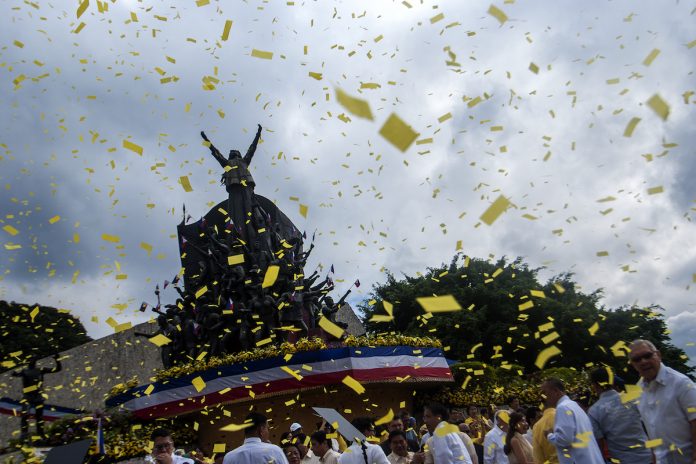The Philippine government has not made any announcement about any observance of the anniversary of the 2001 “People Power” uprising that deposed a president 19 years ago.
It is not surprising. Most of the main protagonists and antagonists of the 2001 uprising are now united behind President Rodrigo Duterte. Others have died.
More importantly, the anti-corruption and anti-tyranny aspirations of what was then known as Edsa Dos do not serve the interests of the current president.
Joseph Estrada and Gloria Macapagal Arroyo are now known allies of Duterte.
Arroyo was sworn in as president on Jan. 20, 2001 after tens of thousands marched to the palace to flush out Estrada.
After his downfall, Estrada was made to face charges of plunder, a key demand of the uprising, and was pursued by groups such as Plunder Watch, formerly known as the Estrada Resign Movement.
Arroyo proved to be no better than Estrada as far as corruption is concerned.
Numerous scandals rocked her presidency, and her regime would offer the Philippines at the altar of neoliberalism with policies of denationalization, deregulation, liberalization, and privatization.
Arroyo reneged on her promise not to run for president in 2004, and evidence of her involvement in electoral fraud fanned nationwide protests.
In September 2007, the court found Estrada guilty of plunder. But less than a month after, Arroyo pardoned him.
Many viewed Arroyo’s pardon of Estrada as a desperate and opportunistic act to preserve her rule.
Cardinal Jaime Sin of Manila, who figured prominently in the 1986 and 2001 People Power uprisings, died in 2005.
Catholic prelates persisted in their support for Arroyo, despite growing public disenchantment with the president and over corruption in government.
Worse, seven bishops would later be found to be willing recipients of Arroyo’s questionable donations of Mitsubishi Pajero vehicles.
Activist priests, religious leaders, and cause-oriented groups assailed church officials for banning demonstrations at a shrine where the uprisings took place.
The ban emboldened the Arroyo administration to turn the shrine into a fort surrounded by hundreds of policemen in full-battle gear whenever anti-Arroyo activist attempt to gather there.
Arroyo tried to tamper with the Constitution to perpetuate her hold on power and to remove the charter’s protectionist provisions that formed the last bulwark against globalization.
She also attempted to sell out Philippine interests in the South China Sea to Beijing.
On the human rights front, Arroyo presided over the Hacienda Luisita Massacre and a wave of extrajudicial killings that attracted the attention of the United Nations special rapporteur.
She even tried to arrest and jail several members of Congress belonging to leftist parties that played key roles in the anti-Arroyo united front.
Arroyo left office in 2010. In the elections of that year, Benigno Aquino III ran and won on a platform of change and as the grieving son of a recently-departed former president, Corazon Aquino.
Aquino, the mother, figured prominently together with Cardinal Sin in the 1986 and 2001 uprisings.
The Aquino scion beat several foes including Estrada, whose 2007 pardon by Arroyo restored his freedom and civil rights.
The Philippine Church steadily backed the younger Aquino from 2010 to 2016, despite flagrant incompetence, lack of empathy, corruption, and human rights violations.
The eventual victor in 2016 was said to have rode on popular anger at Aquino and at the regimes after the two uprisings for failing to deliver pro-people reforms.
Today, veterans of the Arroyo and Estrada administrations occupy high positions in the Duterte administration, as well as turncoats from Aquino’s former ruling party.
Up until 2019, Arroyo herself served as speaker of the House of Representatives where she shielded Duterte from investigations and presided over probes into his critics, like Senator Leila de Lima.
Estrada lost his re-election bid for the mayoralty of Manila in 2019, but he remains in good graces with Duterte.
Hermogenes Esperon Jr., who served as military chief under Arroyo and whose military leadership the U.N. special rapporteur sought to hold accountable for the extrajudicial killings at the time, is now Duterte’s national security adviser.
He is vehemently opposed to holding peace negotiations with the National Democratic Front of the Philippines.
Duterte continues with his attacks against bishops and the Catholic Church in the Philippines as a growing number of newer prelates challenge his policy of extrajudicial killings in the controversial drug war, and also on causes such as the environment, the protection of the rural and urban poor, and indigenous peoples.
Some Catholic prelates still refuse to confront and assail Duterte over the summary executions.
With an administration such as this, it is no longer a surprise that there’s no celebration of the second People Power uprising of 2001. Neither would there be a commemoration of the first 1986 uprising, because Duterte has openly come out as a loyalist and ally of the dictator Ferdinand Marcos and members of the dictator’s family.
Nevertheless, Filipinos can still draw a simple yet powerful lesson from both uprisings, and it is a lesson that Duterte may fear and do everything to stifle: We as a people toppled leaders twice, and we can do it again.
Tonyo Cruz is a Filipino blogger, newspaper columnist, and convener of the media and arts alliance Let’s Organize for Democracy and Integrity. The views and opinions expressed in this article are those of the author and do not necessarily reflect the official editorial position of LiCAS.news.









